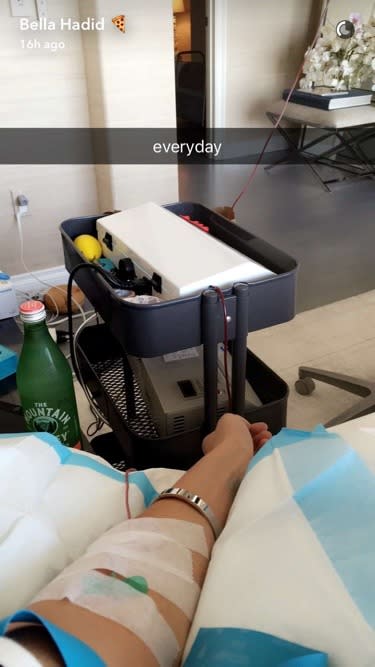Bella Hadid Shares Photo of Her ‘Everyday’ Struggle With Lyme Disease

Bella Hadid shared a snapshot of what her life is like with Lyme disease. (Photo: Getty Images)
Model Bella Hadid offered her fans a glimpse into her “everyday” reality.
On Monday, the 19-year-old daughter of Yolanda Foster underwent an IV treatment for Lyme disease and documented the experience via Snapchat. She did not identify the type of treatment she was receiving.
Last year, Yolanda, who also suffers from this illness, revealed that Bella and her younger sibling, Anwar, were diagnosed with the condition in 2012.
Approximately 30,000 cases of Lyme disease are reported each year to the Centers for Disease Control and Prevention (CDC).

Bella shared a Snapchat video of herself getting an IV infusion apparently to help with her Lyme disease. (Photo: Bella Hadid via Snapchat)
“Lyme disease is a bacterial infection that people get from the bite of an infected tick,” Jennifer Caudle, a family physician and assistant professor at Rowan University School of Osteopathic Medicine, tells Yahoo Beauty.
The typical initial symptom is a rash — “the bull’s-eye or the target rash,” notes Caudle. “But people can also get additional Lyme symptoms since Lyme can affect many different parts of the body, not just the skin.”
Other common symptoms include fever, headache, joint pain, stiff neck, and fatigue. “I’ve also seen Lyme arthritis, meaning that the disease can affect the joints,” Caudle says.
In the majority of cases, Lyme disease is treated successfully with antibiotics over the course of two to four weeks. However, Caudle — who frequently treats patients with this condition at the Rowan School of Medicine Department of Family Practice in Stratford, N.J., being that the northeast is one of the most highly concentrated areas of this vector-borne illness — states that some patients will complain of fatigue, joint pain, and/or muscle aches after the antibiotic regiment has been completed.
“The CDC refers to this as post-treatment Lyme disease syndrome,” Caudle says. While the exact cause is still unknown, these lingering symptoms can last for more than six months. Long-term antibiotic treatment has been associated with other complications, which is why doctors may treat these patients similarly to those suffering from fibromyalgia or chronic fatigue syndrome, according to the CDC.
The good news? “Many of these patients will get better with time,” Caudle says.
As far as what type of treatment Bella is getting, that remains a mystery. “Nowhere does the CDC recommend IV infusions, which is where my concern and questions come from,” Caudle says. “So I cannot speak to what [Bella] is getting because honestly, I have no idea.”
Let’s keep in touch! Follow Yahoo Beauty on Facebook, Twitter, Instagram, and Pinterest.
